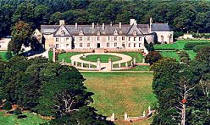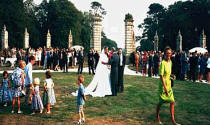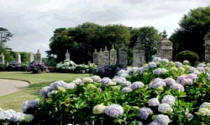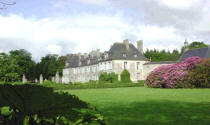![]()
![]()
![]()
![]()
![]()
![]()
![]()
![]()
![]()
![]()
![]()
![]()
![]()

Click here for a virtual visit
History
The area around the castle was settled very early in history. At first, it was a
prehistoric settlement. The finds dating back to that period were recorded by
Brittany's Archaeological Department before the Second World War. Later, the
Romans constructed a camp on the site in preparation for invasion of Great
Britain. During the ninth and the tenth centuries, the Normans invaded Brittany
and caused terrible wars which unfortunately affected the chateau. The first
manor was built in 1010. Being aware of the fact that the South Finistere coast
was completely unprotected against invasions, the Duke of Brittany gave the land
to one of his knights, who bore the name of Guilguiffin. Furthermore, he
conferred upon him the title of Baron and obliged him to protect and cultivate
the barren land on its southern flank. In 1250, the walls and towers were
fortified. The big courtyard protected the people of the surrounding villages as
well as their animals and various sailors against the frequent invasions. In
1683, Luis XIV had the fortifications Lorient, Brest and Camaret built by his
architect Vauban. As the royal fleet took over defending the sea, the castle
lost its original importance as fortification. In the eighteenth century, with
the permission of Luis XV, the Marquis de Ploeuc who was the ruler of the region
at that time, had the old walls and fortification demolished. The stones were
used to build the existing castle, at that time a hunting lodge. For the
building of the castle, the Marquis engaged the services of the architect
Nicolas Pochic, because he had travelled in China and India and was regarded to
be both, and an expert in oriental architecture. This is shown in circular
arrangement of columns in the park in front of the castle which was inspired by
the Indian Temple of Angkor-Vat. It was the present owner, Philippe Davy, who
constructed the third row of columns as had originally planned. With a lot of
expertise and hard work, the park return to its original state. For more than
900 years, the chateau has been passed down through the family, five times
inherited by women. The site, the castle with its ground floor salons,
surroundings buildings, the columns, the walls and the park are all classified
with the French National Historical Registry.
The Park
In front of the chateau, a courtyard of honour leads to an esplanade from which
fan out five avenues on the main axis and three hews of walls with pillars
inspired from Asia. Two great pillars topped with granite sculptures of wild
boars chassed by hounds move the entrance to the main front courtyard. To the
east, the two year old vegetable gardens surrounded by high walls has been made
into beautiful garden for you pleasure. The pontic rhododendron, the old apple
trees planted along the wall, some topiaries, recall the time of their popular
use at the 17th century, the palm trees Himalayas are of a more recent time, the
14th century. In one field to the southwest, an old dovecote with 640 nests,
once privilege of the nobility, recalls days past. More recently, a farm
installed in the outbuildings ruined the 's park's elegance been the pride of
his previous owners. Some avenues had disappeared completely, replaced trees or
fields. The park had become a barn yard. It lasted several years and the
original plan did not endure the stampings of the cows. The first objective was
to redraw the park to accentuate the architecture. It was necessary to replace
new avenues through woods and fields, to rebuild the retaining walls, to replant
the edges and restore the alleys. This was followed by much new planting of
flowering bushes.
Gardeners House
A little house in a green and wooded area at the entrance of the estate, antique
furniture and lots of charm. On the ground floor, a little living room with a
chimney, entrance and kitchen. On the second floor, a double room and a large
bathroom and on the third floor, a double bedroom and a single bedroom.
Cottages
A romantic house, full of charm, furnished with rustic antiques with a lovely
garden. On the ground floor, two bedrooms, a bathroom, living room and small
kitchen.
Weddings & Receptions
The great hall, the terrace and the front courtyard will accommodate 350
persons. Dinners under marquees allows a variety of entertainment and number of
guests with a view of the Chateau which is illuminated at night.
Meetings & Seminars
We can organize all types of seminars according to your needs with intimate or
elaborates dinners. You may amuse your guests by inviting folkloric musicians or
hunting horn players in the garden or main hall.
Horse Riding
If you are a rider an wish to come with your own horses, we will be delighted to
accommodate you and your horses. We can offer you a beautiful stable, and
paddocks and 11 km of trails. The beaches at Penhors is 10 minutes away by car,
and at low tide you can ride on 32 km of beaches. You may take care of you own
horses for 19.82 Euros per day including hay and oats.





